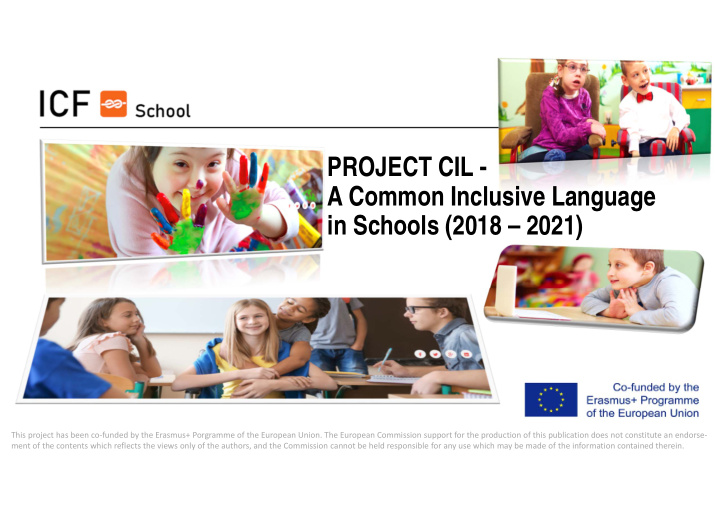



PROJECT CIL - A Common Inclusive Language in Schools (2018 – 2021) This project has been co‐funded by the Erasmus+ Porgramme of the European Union. The European Commission support for the production of this publication does not constitute an endorse‐ ment of the contents which reflects the views only of the authors, and the Commission cannot be held responsible for any use which may be made of the information contained therein.
ICF IN SCHOOL : Indispensable Resource for Participation 15.11.2019 University in Skopje Silvia Kopp-Sixt, MA & Katerina Todorova, MSc
1. Austrian routes to inclusion 2. Teaching for inclusion 3. Inclusion orientated school development
1. AUSTRIAN ROUTES TO INCLUSION
Country: Austria Region: Styria Pupils 577.404 72.000 Schools 6.025 890 Teachers 129.458 16.241 Inclusion quota 61% (all pupils 6 – 19 years)
Country: Inclusion Region: Inclusion Austria quota: Austria Styria quota: Styria Primary schools 6 – 10 y 3.033 65% 451 87% Secondary schools 11 – 15 y 1.131 64% 166 83%
2. TEACHING FOR INCLUSION
Inclusion quota: 85% 30 years of experience
1984 1985 1980 1st class in 1st class in parents Oberwart City Kalsdorf City 1993 1996 Act for Primary School Act for Lower Secondary School
The first question of teachers: WHAT ABOUT THE DEVELOPMENT AND LEARNING of this single child?
Education reports and Beobachtungen …interests, talents, TO DOs for teachers… observations LERNTYP learning personality… processes products ZIEL und METHODE Orientation Orientation in in life: education in general: GOALS GOALS
O3
to adress colleagues of all COMMON LANGUAGE https://www.phst.at/ausbildung/studienangebot/sekundarstufe‐berufsbildung/soziales/ professions „Professionals / Experts for learning“
other important persons COMMON LANGUAGE to adress parents and https://www.phst.at/ausbildung/studienangebot/primarstufe/erweiterungsstudien‐primarstufe/ „Professionals / Experts of Life“
The POWER of ICF
O2
International perspective Teacher Education for Inclusion (TE4I) European Agency for Development in Special Needs Education (2012) Quelle: https://www.european‐agency.org/agency‐projects/Teacher‐Education‐for‐Inclusion
International perspective Teacher Education for Inclusion (TE4I) European Agency for Development in Special Needs Education (2012) knowledge skills attitudes Wissen Handeln Haltung valuing pupil diversity: Wertschätzung der Diversität von Lernenden supporting all learners: Förderung aller Lernenden working with others: Arbeiten mit anderen continuing personal professional development: lebensbegleitendes berufsbezogenes Lernen
The POWER of the TEAM https://www.phst.at/ausbildung/ausbildung/ Models for Co‐Teaching: For example: https://d2ybydxsquared.files.wordpress.com/2013/04/team‐teaching‐outline.jpg
The POWER of school SQA Austrian school quality management system based on action and development plans development MAIN TARGET Developtment of learning and teaching towards • individualization, • competency support, • inclusion
Quality development based on the Index of inclusion Booth / Ainscow 2003
The University College of Teacher Education University College of Teacher Education Styria Graz, Styria/Austria f
Conclusion for Inclusion Inclusion in Inclusion in ongoing pre‐service teacher teacher education on‐ education the‐job Inclusive Inclusive university school development development
We are 65% water… …the rest is attitude!
Quellen und Literaturempfehlungen • Lani,F. (2014). The SAGE Handbook of Special Education. London: Sage. • Nind, M. (2014). What is inclusive research? New York: Bloomsbury. • Schuntermann, M. (2018). Einführung in die ICF. Landsberg am Lech: Ecomed Medizin. • Paulus, Ch. (2014). Einstellungen zu Inklusion: Die Deutsche Fassung des MTAI. Verfügbar unter: https://dx.doi.org/10.22028/ D291-23366[5.8.2019] • Pickl, G; Holzinger, A.; Kopp-Sixt, S. (2015). The special education teacher between the priorities of inclusion and specialization. International journal of inclusive education. http://dx.doi.org/10.1080/13603116.2015.1115559 • Pretis, M. (2018). Let us be prepared, but wait and see: the use of ICF-CY in early childhood intervention and pediatric social care in Germany and neighbouring countries. In: Castro & Palikara (Eds), An emerging approach for education and care. Implementing a worldwide classification of functioning and disability , (165- 178). London: Routlegde. • Pretis, M.; Kopp-Sixt, S.; Mechtl, R. (2019). ICF in der Schule. München: Reinhardt. • Stoiber, K. C., Gettinger, M., & Goetz, D. (1998) Exploring factors influencing parents’ and early childhood practitioners’ beliefs about inclusion, Early Childhood Research Quarter-ly, 13, 107-124. • UN (2006). Convention on the rights of persons with disabilities and optional protocol. Retrieved from http://www.un.org/disabilities/documents/convention/convoptprot-e.pdf [6.8.2019] • UNESCO (2008). Inclusive education: The way of the future. Reference Document. International Conference on Education, 48th Session, Geneva 25 November. Retrieved from http://www.ibe.unesco.org/fileadmin/user_upload/Policy_Dialogue/48th_ICE/CONFINTED_48-3_English.pdf [6.8.2019] • World Health Organization. (2007). International classification of functioning, disability and health: children and youth version: ICF-CY. World Health Organization. Retrieved from http://www.who.int/iris/handle/10665/43737 [6.8.2019] Website https://www.icf-school.eu Kontakt: silvia.kopp-sixt@phst.at
Recommend
More recommend